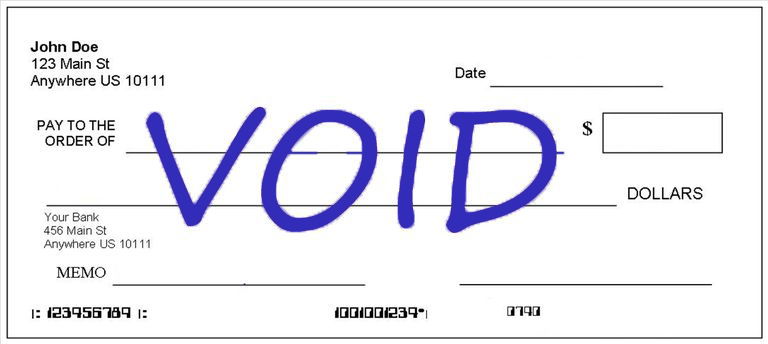While many people have switched to using debit cards instead of paper checks, there are times when you may still need a check. There are also instances when a company requests a voided check, or when you wish to have a check voided for your own purposes.

Rather than figuring out the process as it comes up, learn everything you need to know about voiding a check now so that you’re fully prepared in the future.
What is a voided check?
A voided check is easy to recognize. It is a paper check with the word VOID written on it. It may or may not have other information filled in throughout the check. The text should be clearly seen, but it doesn’t cover up any other writing beneath it.
Once a check has been voided, it’s no longer usable as a form of tender. No matter who the check was written out to or how much it might be written for, the check can no longer be presented to a bank or credit union for payment.
What is the purpose of voiding a check?
When a person voids a check, it can no longer be used. It is disabled as a form of payment. Even if the check has been made out to an individual, store, or other institution, it can no longer be used. And if the check is blank, the fields can no longer be filled out and used as payment.
The person who receives a voided check cannot fill in the amount and other details and present it to a bank. It also prevents a thief from taking the check, filling out an amount, and forging your signature to debit funds from your bank account.
What is a voided check used for?
There may be several instances when someone could ask you to void a check. The most common use is for a company to use it in setting up direct deposit.
The information on the check is still valid and tells the person or business several important pieces of information, including the following:
- Your name and address
- Other personal information, such as phone number or driver’s license number
- Bank institution name
- Bank routing number
- Bank account number
- Check number
This information is most often used to set up an electronic link to your bank account. For example, you can provide a voided check to a person or company. They will then take that information and request an authorized withdrawal or payment to your checking account. Here are some common scenarios for which you’ll need a voided check.
Direct Deposit
One of the most routine instances of voiding a check is for setting up direct deposit with your employer. The company may ask for a voided check to enter your checking account information (routing number and account number) in its system to set up direct deposit for your paycheck.
Direct deposit eliminates the need for you to receive a paper paycheck and often allows the money to be deposited into your bank account faster. Many companies allow you to fill out a direct deposit authorization form. However, some still require a voided check for direct deposits.
Automatic Electronic Payments
You can also use a voided check to set up automatic payments to come out of your checking account automatically.
This may include rent, mortgage payments, utility payments, or other recurring bills. In addition, a voided check takes away the hassle of sending in payments or setting up an online payment each month because it automatically comes out on the specified date.
Mistakes on Checks
Sometimes mistakes happen when writing a personal check, like putting in the wrong name or incorrect amount, rendering it useless. A voided check can be used in such cases. Writing the word “VOID” on top of the written information prevents someone from using it. This is the third instance where a voided check is beneficial.
Let’s say you intended to write a $50 check, but mistakenly added an extra zero, making it $500. To prevent the check from being processed for the wrong amount, you void it by writing “VOID” on top of the written amount.
Although some mistakes can be corrected by marking the incorrect information and initialing it, this is not always a safe practice. It’s essential to note that some businesses may not accept such corrections. The check could still be run through the bank’s system for the incorrect amount. And in such cases, the mistake may not be noticed until the check is returned to your bank or rejected by the recipient’s bank, causing the check to bounce.
Keeping a partially written check around without voiding it is risky as it could be stolen. Thus, it’s always best to void any check that can no longer be used by writing the word “VOID” on it. Remember, it’s better to be safe than sorry when it comes to writing checks.
How to Void a Check
If someone requests a voided check from you, it’s easy to take care of. Simply use a blank check and write ‘VOID’ in large letters across the front. Then, use a pen with black ink and make the word large enough to be read.
Also, ensure it’s written across the entire check, but don’t write over the information at the bottom of the check since it includes important banking information.
However, you want to make sure the word is clearly seen so that thieves can’t write in any information and cover up the word. You don’t need to sign the check or add any other information when you’re voiding it. Next, list the check in your check register so that you don’t forget where it went.
Counter Check
If you don’t have a voided check to supply to a third party, you do have other options to get one. You can ask your bank for a blank check, which is known as a counter check. Many times, this won’t have your personal information written on top, but it will include your banking information.
Not all companies will take a counter check, so make sure you find out if it’s acceptable. You may also be able to use a deposit slip with your bank account information on it.
Another less common way to void a check is by writing ‘VOID’ in three places: the signature line, payment box, and in the “pay to the order of” section of the check.
Bottom Line
Voided checks may not be as popular as they once were, but it’s still important to know how to void a check, what they look like, and what their purpose is. Always remember to keep track of any checks you void out to prevent identity theft or fraud.
Frequently Asked Questions
Can a voided check be reinstated or reused?
No, once a check is voided, it cannot be reinstated or reused as a valid form of payment. The act of voiding a check is permanent. It ensures that the check cannot be accepted by banks or financial institutions for payment. If a mistake was made in voiding the check, a new check must be issued.
What can I use if I don’t have a voided check?
If you don’t have a voided check, there are several alternatives you can use to provide your banking information for purposes such as setting up direct deposits or automatic payments. One common alternative is a bank deposit slip, which also contains your routing number and account number.
Additionally, many banks can provide a pre-printed letter or document that verifies your account details. Some institutions may accept a printed online banking statement that includes your account and routing numbers. Lastly, digital forms or authorization through your bank’s online system to provide the necessary information electronically are increasingly accepted.
Can I void a check after it has been partially filled out?
Yes, you can void a check after it has been partially filled out. If you’ve made an error or no longer wish to use a check that you’ve started writing, simply write “VOID” across it as described above. This will prevent anyone from completing and using the check. However, remember to record this action in your check register to keep your financial records accurate.
How long should I keep a record of voided checks?
It’s a good practice to keep a record of voided checks for at least one year to ensure you have a clear financial trail for tax purposes or to resolve any disputes that may arise. Some financial advisors suggest keeping all bank records, including voided checks, for up to seven years, consistent with the period for which the IRS recommends retaining tax documents.




